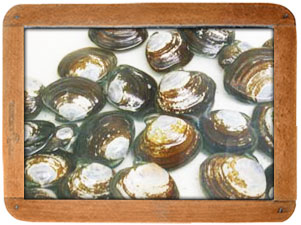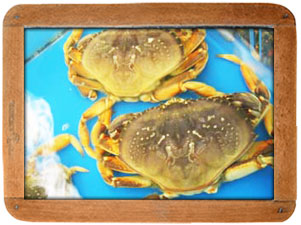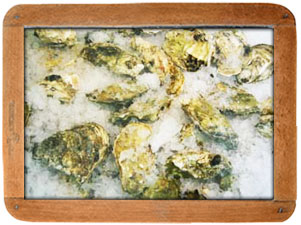Seafood Safety
Print this pageSeafood safety is wildly important
In order to get the best from every seafood meal, please follow the guidelines below to ensure the safety of your family, friends and patrons.
Please remember seafood is a highly perishable product with a short shelf life. Be sure you always buy your fish as close to when you want to serve it as possible. If you are unsure, always ask for directions from your seafood retailer.
- Clams and Mussels
- Product Susceptible to "Gas" Build Up
- Avoiding Contact with Water
- Live Crabs, Lobsters & Crayfish
- Live (in shell) Oysters
- Misunderstood Seafood
- Mahi Mahi, Ahi & Kajiki
- Sharks, Swordfish & Rays (skate)
Clams and Mussels

Inspect the product as soon as possible. Discard any broken shells. Some may "gape", but this does not necessarily mean they are dead. Agitating or tapping them will make the live ones close slowly. Ice your bi-valves and keep them in your refrigerator. This will keep them as close to zero degrees as possible, greatly retarding bacteria growth. Make sure the product is in a container that allows the melted ice (water) to drain away, as the product can drown if submerged for too long. Don't put your bi-valves in a sealed container or cover them with plastic wrap, as they need to "breathe", but don't let them dry out either. Top with crushed ice or a damp cloth is best.
Product Susceptible to "Gas" Build Up
Scallops, shucked oysters, shrimp meat, and ground fish fillets (sole, snapper & cod) may smell "off" when the container they come in is first opened. This is because of gases given off due to natural (and harmless) bacteria growth. On receipt of these products, it is advisable to open the container or bags, allowing these gases to disperse; you will soon notice that your product smells fine. Remember: the warmer the product - the better the environment for bacteria, so keep your seafood cold!
Avoiding Contact with Water
Although direct contact with ice is good for shellfish, it is generally not advisable for finfish, especially where the flesh is exposed. As the ice melts in to water, the water draws out the blood and other juices from the fish, causing it to pale and discolor. This is of course most noticeable where the fish's color is important, i.e. Ahi (yellow fin tuna), Salmon, Kajiki (marlin), swordfish, shark and sailfish. A good rule of thumb is "if a knife has been there, keep ice and water away". Whole, gutted fish are not a problem, because there is a membrane in the belly wall, which doesn't allow water to penetrate into the flesh.
Live Crabs, Lobsters & Crayfish

When purchasing look for a thick hard shell. The animal should "feel" heavy for its size. Softer shells and light weighted animals indicate a recent molt, (molting is when a crab, etc. grows too big for its shell, so it discards it while growing a new shell underneath). The meat content is poor just after a molt. The animal should be very lively and have a good deal of leg movement. Keep your crustaceans in a cool, moist and dark place. This will help to slow their metabolism and lengthen their lives. Do not store in ice or water. For maximum flavor and meat content, cook and serve as soon after purchase as possible. If the product appears dead or dying, cook immediately. You may then hold it (well chilled) for an additional day or two before serving or freezing. Never freeze the product without cooking it first.
Live (in shell) Oysters

Store oysters with the deeper half of the shell facing downwards. This will prevents the nectar (juices) from leaking out. Ideally, oysters should be held at 3 degrees C. (39 degrees F.), but better cooler than warmer. Keep them moist by covering them with a damp cloth or burlap, away from sunlight, and protected from circulating air which will dry them out. If properly handled, Pacific oysters can stay fresh and alive for a week or more. Atlantic types (such as Malpeque) even longer. Atlantic oysters such as Malpeque, Blue Point, Blue Nose, James Point, etc., don't be alarmed when these oysters, unlike Pacific varieties are sold with mud on them. The principle reason why these animals will stay alive longer is that they actually continue to feed off the mud. Rinse them off before shucking. Discard any that are gaping (open) or bad smelling. If in doubt, don't serve them.
Misunderstood Seafood
There are types of seafood that don't follow the rules when it comes to appearance, odor, or shelf life. Following are some examples. B.C. Spot Prawns being a deep cold water prawn, the BC spot prawn exhibits the opposite characteristics of the black tiger in almost every way, e.g., if overcooked, a spot prawn turns mushy while a black tiger becomes firmer. As BC prawns are trapped in deep water, their livers burst while being brought to the surface (decompression). This is why the prawn's heads will turn black within 48 hours. If the head is left on the prawn, it will spoil the tail meat that much sooner. If buying whole spot prawns, its best to cook them immediately, or remove the heads. Either way, the prawn will last, if well iced, for about 4 days.
Mahi Mahi, Ahi & Kajiki
Mahi Mahi also known as Dorado or Dolphin but don't get upset; it is a fish not a mammal and is not a dolphin or porpoises. Mahi Mahi, Ahi Tuna, Kajiki (Marlin), or Sailfish are quick to oxidize (absorb oxygen in to the flesh) which cause the exposed flesh to turn brownish color. To keep this to a minimum keep the meat covered in plastic wrap and away from air and water.
Sharks, Swordfish & Rays (skate)
This family of fishes is one of the oldest known, having been around since the age of dinosaurs. They have no bones - only cartilage, and no urinary tract. Sharks, swordfish and skate excrete liquid waste through their skins. Subsequently, there are typically high concentrations of urea in the flesh of these animals; it readily converts to ammonia once the fish has been harvested. The meat of these fish may be soaked in a brine solution or marinated in an acidic solution such as vinegar, lemon juice or milk (lactic acid) to neutralize the ammonia.



